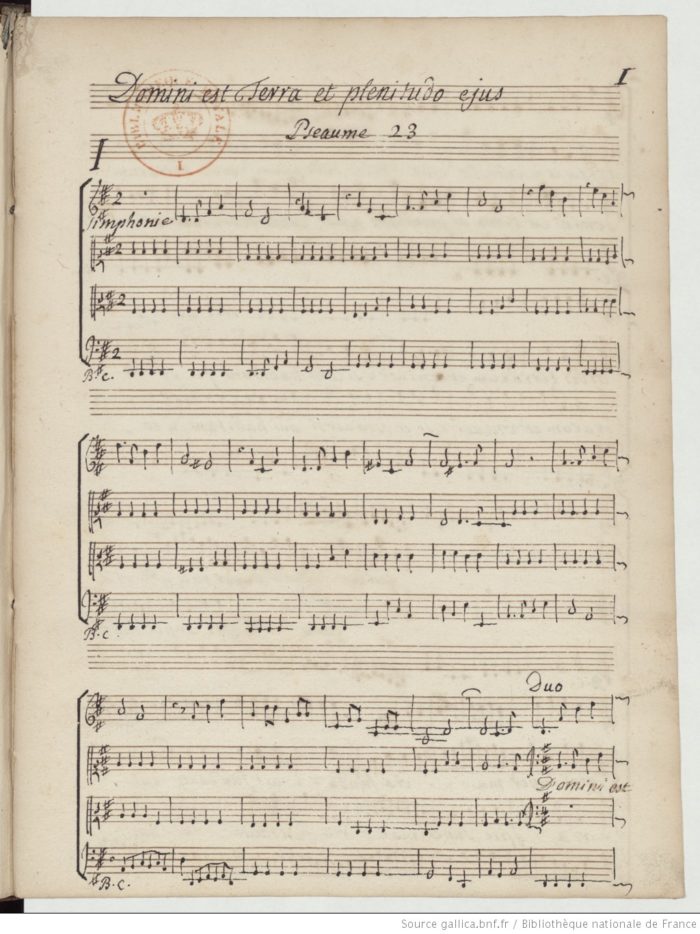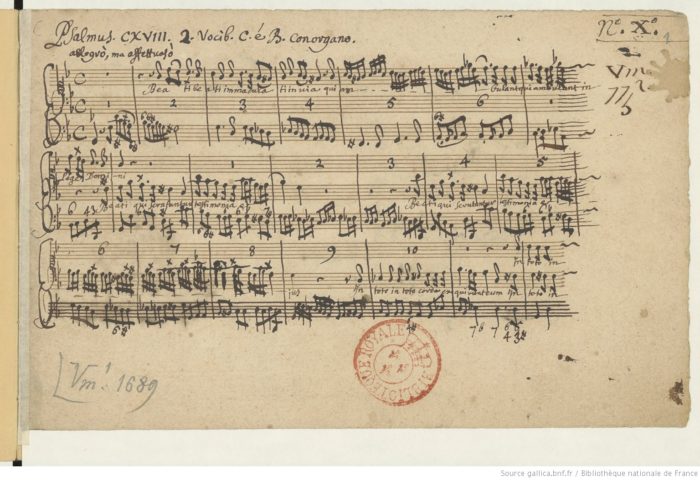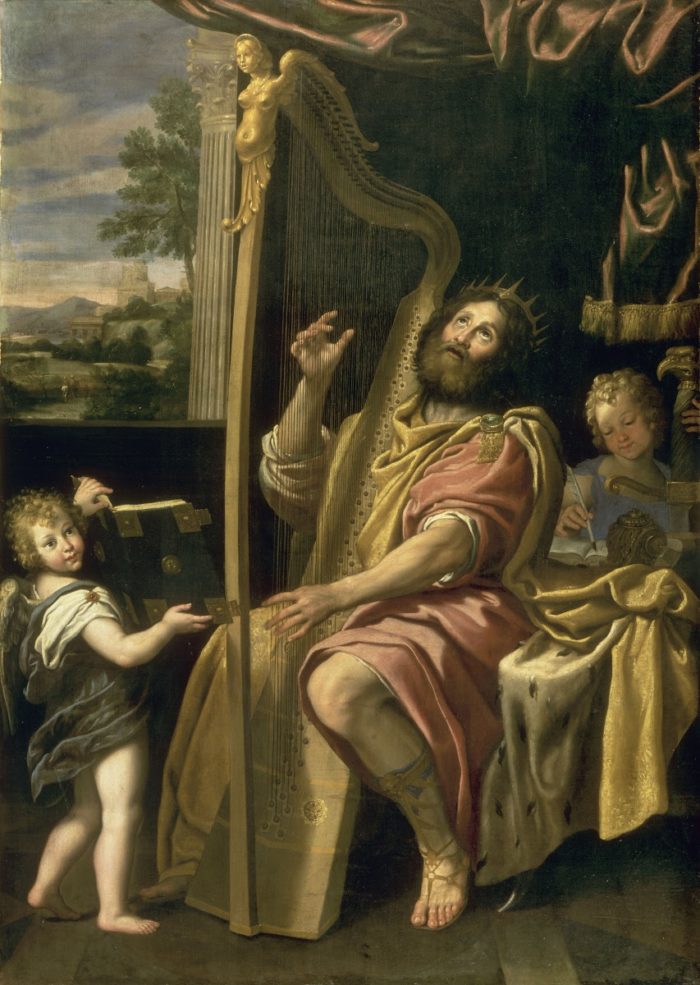Psaume XXIII : Domini et terra et plenitudo ejus
Psaume XXIII : Domini eſt terra et plenitudo ejus
by Gabriel Doyen
While the Bible is mostly known for being a religious text carrying the history, traditions and precepts upon which judaism and christianism are based upon, a particularly important part of it is the Psalms. Those songs which are said to have been written by King David himself during his reign, have been an integral part of religious celebrations for centuries. Musicians across countries made their own version of the psalms, not only with melodies but also depending of the translation they have been using. While not as influential as whole new translations or interpretations of the sacred texts, musical scores of the Psalms are a great support to observe the place in which position the Bible is in societies.
In the 18th century Kingdom of France, they were many versions of the musical Psalms circulating, and new versions were being made for various reasons such as commands from the Church, artistical works or for royal celebrations. One of the institutions which has produced many musical religious works is the Chapelle Royale (Royal Chapel) of Versailles. The Chapelle Royale is an old institution dating back to the Merovingian, whose role was to sing religious services for the king. While it has sharply declined after the death of Louis XIV, under Louis XV new Sous-Maîtres de Musique (Sub-Masters of Music) were hired, and the institution kept playing for the sovereign until its dissolution in 1760. It is a great source of musical Psalms and the origin of the piece I’m examining.

- Author: Gervais Charles Hubert
- Title: Domini est terra et plenitudo ejus
- Date: between 1723 and 1744
- Pages: 35 pages
- Language: Latin
Purpose : A work of duty
This rendition of Psalm XXIII is a creation of Gervais Charles Hubert, as part of his duty as Sous-Maître de Musique in the Chapelle Royale of Versaille. This motet, a form of muscial composition which appeared first in the 13th century, has been created for the purpose of being played during either one of the daily mass or in a celebration organized by the Chapelle Royale for the King of France, which was at the time Louis XV. As each of the Sous-Maître had a dedicated time of the year during which their work was played in mass or celebration, they had the duty of providing for the King a number of musical scores. An it was a much more important task than it looks at first.
Under Louis XIV, with the incredibly ritualized court, assisting to the morning mass with the king was extremely important, less by religious fervor and more by social obligation. By consequent, the music involved in the mass was extremely important for the social standing of the musical master in charge of the time period in which the mass was happening. The effectiveness of an original composition for the king’s goodwill would be largely superior a motivation for a musician to create their own musical scores for the psalms. While Louis XV was less lenient toward the Chapelle Royale than its predecessor in term of budget and attention, the duty remained the same.
Formal Aspects : What a plain appearance can tell us
This is a manuscript autograph of 25 x 19 cm size. The binding is the original one as the marbled pastdown can attest. The binding is made of brown calf, in good condition, while the inside content is as well devoid of damage. The title is an impressed piece, that has been cut and then attached to the manuscript. This is an oddity of the book, beyond its manuscript nature, to have an a dissociated, impressed part, yet comparison with other manuscript from musicians of the period can attest it wasn’t such a rare occurrence. A musical manuscript originally made alone in that time period will sometimes later have a cover added later, as shown with other works of the 18th century. All in all, a very plain manuscript, yet it is very indicative of the nature of such compositions. The following image is another manuscript from a composer of the time, which was later covered with a printed cover.

A manuscript can mean the work was not destined to be mass produced. In fact, it appears only a single exemplar of this work and the one shown above exist, in possession of the Bibliothèque Nationale de France (National Library of France). By comparison, the works destined to the public are very different: they are printed with miniatures, initials and beautiful colors. For this work to be written as a manuscript this means the psalm is either known by heart or copied from somewhere else. Both are possible, but the first is most probable: the author worked at the Royal Chapelle and with liturgical music, meaning he would have had a deep knowledge of the religious texts.
This manuscript was given to the royal library by the author’s daughter, at an unknown date. Once again, it fits as a singular piece made specifically as a work produced for the sole purpose of being played in the Royal Chapel, likely under the direction of its author. This is confirmation that this work was never destined to the public or made with financial goals in mind, which eliminate the principal reasons as to why a work would be brought to the printer for mass distribution.
Political Value : The King as David’s successor
The connection betwen music and royalty is one often ignored, yet is an important part of the iconography surrounding the supposed divine right to rule that was enfored by the French monarchy. Even though the kings may not have been great musicians by themselves or even not interested in music at all, like Louis XV had been, paintings or engraving will represent them playing an instrument, more often than not the harp, the very same instrument King David is using. This is of course no coincidence, and for deeper reasons than a simple attachment to the figure of the ancient israelite king, whose most known image is that of a shepherd guiding his lambs like the king guides his sbjects, an image that is reinforced by the Psalm XXIII evocating the Lord as a shepherd.
Music has often been associated with the health of the mind, more accurately it has been seen by greek philosophers among others as a remedy to the ailments of the soul, something which can bring harmony. In the Bible, it gained a prophetic connotation as it gains, in the hands of one chosen by God such as David, the ability to cure Saul of his madness or chase the evil spirits that have taken hold on him. By associating the King to David the musician, he becames the physician of the kingdom, meaning he was both considered the caretaker of a patient (the kingdom) only he can understand the issues of, and it reinforced his connection to God as his agent on Earth and the new incarnation of a widely revered ancient king.
All of this participate in a seemingly banal but important point. The work of Gervais uses the Vulgate as an exact source for the Psalms, without either adding, soustracting or altering the content, as it is his only option. The kindom of France in the 18th century was one of the most ardent defenser of Catholicism, especially since the revocation of the édit de Nantes (Nante edict) in 1685, prohibiting Protestantism in French territory and hardening the attitude of the religious authorities against any deviations, especially in arts. The King only being presented works in perfect adhesion to the canonical order shows how important it is as a foundation of his power, even in the smallest details.




